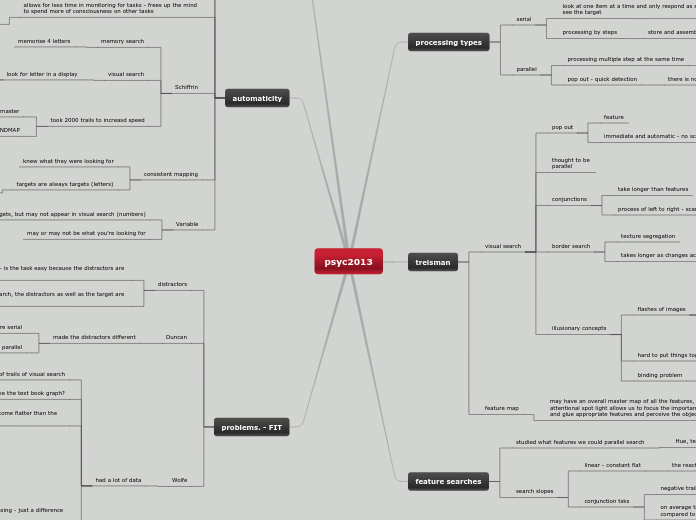psyc2013
processing types
serial
look at one item at a time and only respond as soon as you see the target
as we increase distractors we have increased response time
processing by steps
store and assemble after each step
parallel
processing multiple step at the same time
store and assemble all steps simultaneously at the end
pop out - quick detection
there is no change to response time as we increase distractors
treisman
visual search
pop out
feature
immediate and automatic - no scanning or searching
thought to be
parallel
conjunctions
take longer than features
process of left to right - scan
border search
texture segregation
takes longer as changes across border are more complex
illusionary concepts
flashes of images
red car and blue toy
blue car and red toy
noticing shapes and colors, but not putting it together coherently
hard to put things together without attention
binding problem
thought to support serial processing
feature map
may have an overall master map of all the features, but our attentional spot light allows us to focus the important features and glue appropriate features and perceive the object
build an object file using features bound together
feature searches
studied what features we could parallel search
Hue, terminators etc.
search slopes
linear - constant flat
the reaction time is independent of the display size
conjunction tsks
negative trails
take longer on average as its harder to say no
on average takes much longer for greater numbers of displays compared to single feature targets
automatic processing
automaticity
per attentive
happens without any learning
built into visual system
automatic process
requires learning and a lot of practice
allows for less time in monitoring for tasks - frees up the mind to spend more of consciousness on other tasks
fast, run in parallel, don't draw on any central capacity. unavailable to consciousness and unavoidable, ballistic. Hits target no matter what you do. assumption that automatic processes can be interupted
Schiffrin
memory search
memorise 4 letters
visual search
look for letter in a display
1 or 4
searching through memory? or physical items
took 2000 trails to increasd speed
said that practice takes a long time to master
LOOK UP OTHER MINDMAP
consistent mapping
knew what they were looking for
targets are always targets (letters)
every item you saw a K or H you knew you would be looking for it
Variable
given targets, but may not appear in visual search (numbers)
may or may not be what you're looking for
problems. - FIT
distractors
are all the same - is the task easy because the distractors are all the same?
in conjunctive search, the distractors as well as the target are all different
Duncan
made the distractors different
the search became more difficult and more serial
less parallel
Wolfe
had a lot of data
put together millions of trails of visual search
did it come out like the text book graph?
search results for feature searches did come flatter than the conjunctions
never completely flat for feature searches
there's not such thing as parallel processing - just a difference in efficiency
we have guided searches and activation maps
activation map for distractors could just be thrown away
differences in efficiency
easy tasks
guided searchs
hard tasks
looking for activation map for red and circular
completely overlapping
inefficient task
heterogenous distractors
faster when the display is larger because the task becomes easier - makes the target more salient
deicion making problem
no difference in feature and conjunction searches
easier tasks has less decisions to be made
